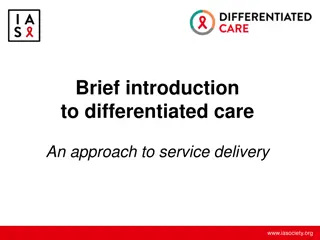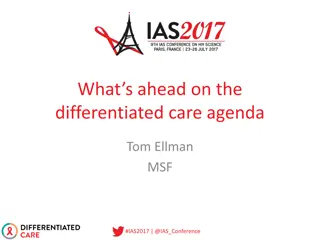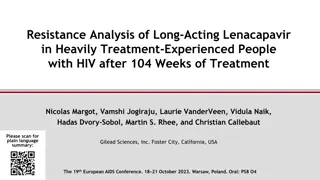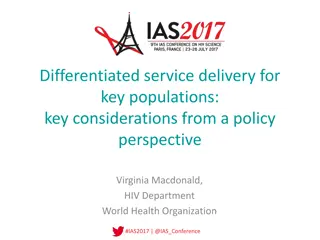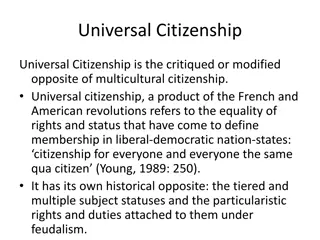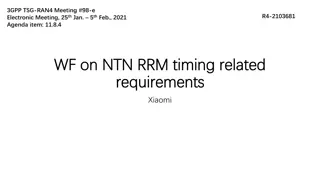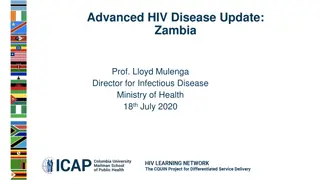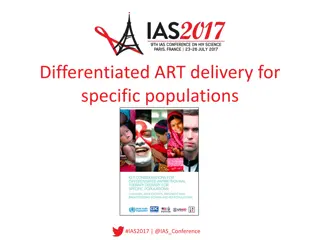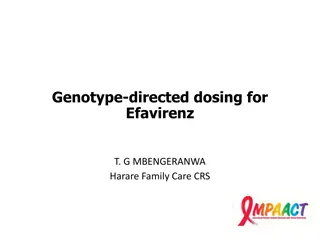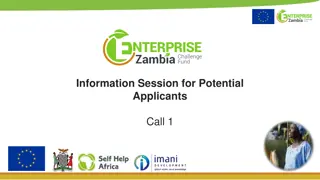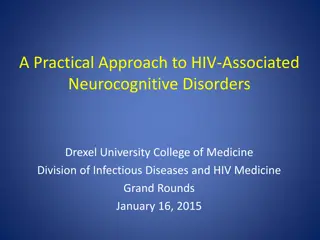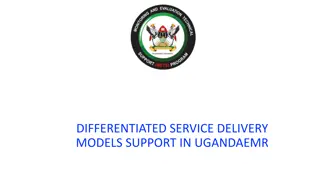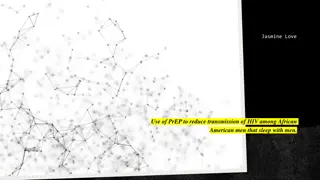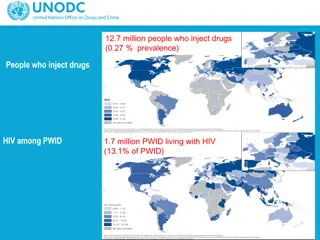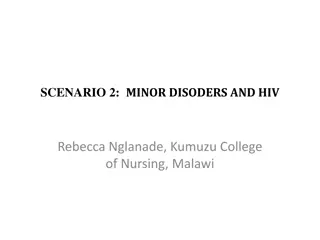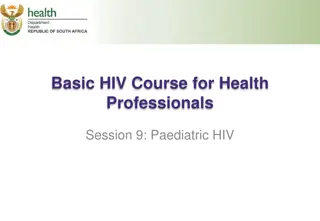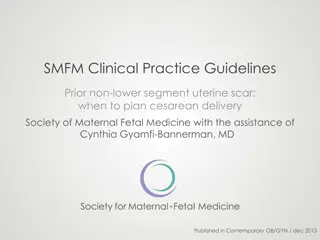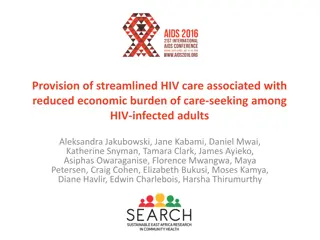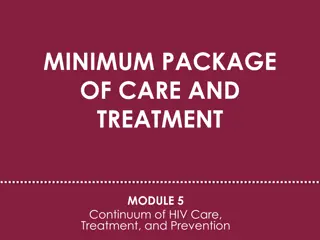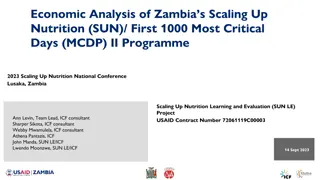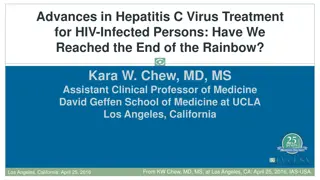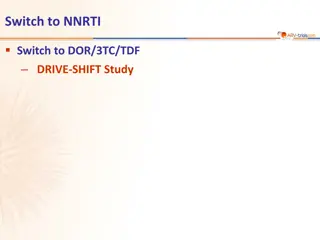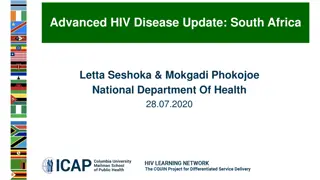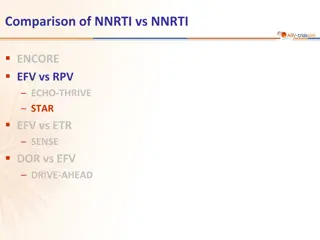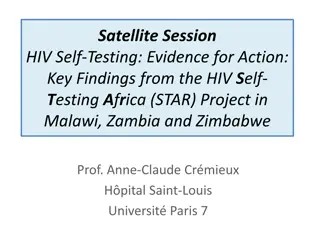Optimal Timing for Differentiated Service Delivery Models in HIV Treatment: A Case Study from Zambia
Attrition rates in HIV treatment programs remain high in sub-Saharan Africa, especially within the first six months after ART initiation. This study in Zambia examines if patients with less than six months on ART should be automatically excluded from differentiated service delivery models. Routine enrollment practices provided insights to address this question.
Download Presentation

Please find below an Image/Link to download the presentation.
The content on the website is provided AS IS for your information and personal use only. It may not be sold, licensed, or shared on other websites without obtaining consent from the author. Download presentation by click this link. If you encounter any issues during the download, it is possible that the publisher has removed the file from their server.
E N D
Presentation Transcript
AIDS 2022 Abstract 08042 How soon should patients be eligible for differentiated service delivery models for antiretroviral treatment? Evidence from Zambia Lise Jamieson1,2, Sydney Rosen1,3, Bevis Phiri4, Anna Grimsrud5, Muya Mwansa6, Hilda Shakwelele4, Prudence Haimbe4, Mpande M Mwenechanya7, Priscilla Lumano-Mulenga6, Innocent Chiboma6, Brooke E Nichols1,2,3 1Health Economics and Epidemiology Research Office (HE2RO), Department of Internal Medicine, Faculty of Health Sciences, University of the Witwatersrand, Johannesburg, South Africa; 2Department of Medical Microbiology, Amsterdam University Medical Centre, Amsterdam, the Netherlands; 3Department of Global Health, Boston University School of Public Health, Boston, MA, USA; 4Clinton Health Access Initiative, Lusaka, Zambia; 5International AIDS Society, Cape Town, South Africa; 6Ministry of Health, Lusaka, Zambia; 7The Centre for Infectious Disease Research in Zambia, Lusaka, Zambia
Background Background Attrition from HIV treatment programs in sub-Saharan Africa is greatest during patients first six months after ART initiation. In Zambia, 50% have interruptions in months 0-6 (PEPFAR, 2021) In South Africa, 26% were lost to follow up by 6 months (Aurum, 2020) Likely reasons for high attrition in first six months include: Good patient condition (high CD4 counts) at initiation, reducing commitment to lifelong adherence Same-day ART initiation, which shifts some losses from before to after starting treatment High and increasing proportion of re-initiators, who have already defaulted at least once and may face the same barriers again Most differentiated service delivery (DSD) models, which make access easier for patients, systematically exclude patients on ART < 6 months, who are considered not established.
As of January 2022, 6 or 12 months on ART was required by most countries for DSD model eligibility Our research question: Should patients with <6 months on ART automatically be excluded from DSD models? Routine enrollment of some new ART initiators in DSD models in Zambia allowed us to answer this question.
Methods Retrospective medical record review in Zambia; data from electronic system SmartCare from January 2019 to October 2021 Included adults ( 15 years) who initiated ART in 2019-2020 and subsequently enrolled in any of Zambia s DSD models Outcome: loss to follow-up (LTFU) within 18 months of ART initiation, defined as no interaction with healthcare system between 15-21 months after initiation Compared: Early enrollers patients who enrolled in any DSD model with <6 months ART experience Established enrollers patients who enrolled in a DSD model with >6 months ART experience Estimated risk ratios of LTFU using log-binomial model, adjusting for age, sex, urban/rural, and ART dispensing interval and stratified by DSD model type and ART dispensing interval
Enrollment and patient characteristics Data from 692 health facilities across all 10 provinces in Zambia Distribution of time on ART at DSD model enrollment (n=6,340) N=32,197 adults who initiated ART in 2019-2020, enrolled in DSD models, and had 18-month outcomes 6,340 early enrollers 1,400 1,200 Number of ART patients 1,000 45% enrolled in month 0-3 55% enrolled in month 4-6 25,857 established enrollers 800 600 400 Early and established enrollers were similar with respect to age (median 37), sex (61% female) and setting (64% urban). 200 0 [0, 1] (1, 2] (2, 3] (3, 4] (4, 5] (5, 6] Months on ART at DSD enrollment
DSD model enrollment and duration Variable Early enrollers in DSD models (N=6,340) Established enrollers in DSD models (N=25,857) DSD type Adherence groups Community medication pickup points Extended clinic hours Fast-track medication pickup at facility Home ART delivery Multi-month dispensing at facility ART months dispensed <2 months 3 months 4-6 months Months on ART at outcome, median (IQR) In DSD model at outcome Yes No Months in DSD model at outcome, median (IQR) 149 (2%) 671 (11%) 85 (1%) 979 (15%) 355 (6%) 4,101 (65%) 508 (2%) 1,461 (6%) 97 (<1%) 6,266 (24%) 973 (4%) 16,552 (64%) 636 (10%) 2,197 (35%) 3,507 (55%) 17.9 (16.4-19.5) 1,476 (6%) 5,688 (22%) 18,679 (72%) 18.4 (16.7-19.8) 6,340 (100%) 0 (0%) 14.7 (13.0-16.5) 20,856 (81%) 5,001 (19%) 5.8 (2.9-8.9)
Rates of loss to follow-up at 18 months 20% Early enrollers Established enrollers 18% Across different DSD models and ART dispensing intervals, early enrollers had similar or lower rates of loss to follow-up 18 months after ART initiation 16% 14% 12% 10% 8% 6% 4% 2% 0% DSD model type ART dispensing interval
Early vs established enroller risk of LTFU by 18 months after ART initiation Adjusted for age, sex, urban/rural setting, and dispensing interval (except last three) Less LTFU More LTFU Early enrollers risk of LTFU was lower than that of established enrollers for most models of care and all dispensing intervals. Results held for those enrolled in month 0-3 after ART initiation as well as those enrolled in month 4-6.
Conclusions Patients who have been on ART for <6 months can successfully be enrolled in DSD models and retained in care Limitations: SmartCare data on DSD model enrolment incomplete; accuracy uncertain Roll of COVID-19 illness and restrictions unclear Selection bias is very likely providers or patients expectations about future adherence almost certainly influenced early entry into DSD models. Behavioural factors that have not been accounted for may make early DSD enrollers fundamentally different from other early ART patients. Despite the selection bias, DSD models do work for some early ART patients, suggesting that the blanket exclusion of those on ART<6 months should be reconsidered.
Acknowledgments Zambian Ministry of Health Bill & Melinda Gates Foundation AMBIT project team in Zambia
Appendix: DSD models in Zambia during the study period (2018-21) DSD model type Adherence groups Model(s) Community adherence groups Description Patient groups ( 6 members) meeting every 1-3 months outside clinics. Members take turns to collect ART for other members at clinical appointments . Patients groups (20-30 members), meeting every 2-3 months; facilitated by health care worker or facility-based volunteer, also providing pre-packaged ART. Rural and urban adherence groups/clubs Extended clinic hours Before/after-hours models, weekend models, scholar models Clinical visit/collect ART outside the conventional operation times at the facility. Fast-track Fast-track Separate, shorter queue to dispense ART at the facility Home ART delivery Home ART delivery Trained community health workers (CHWs) linked to facilities conduct home visits to deliver ART, conduct health screening, monitor adherence and referrals Facility-based, dispensing ART for a longer duration (usually 3 or 6 months). Multi-month dispensing Community medication pick-up points Multi-month dispensing Central dispensing units ART packed at central hub and distributed at multiple approved pick-up points. Clinical visits occur every 6 months at the health facility. Community ART distribution points, Community retail pharmacies, Health posts Mobile ART distribution models ART refills are provided to patients outside of health facilities, eg. schools, churches, community centers, community retail pharmacies and health posts. Clinical outreach team does 3-monthly clinical assessments at community distribution points. This model is usually used for hard-to-reach areas.



